High on the Hog
Posted on June 29, 2018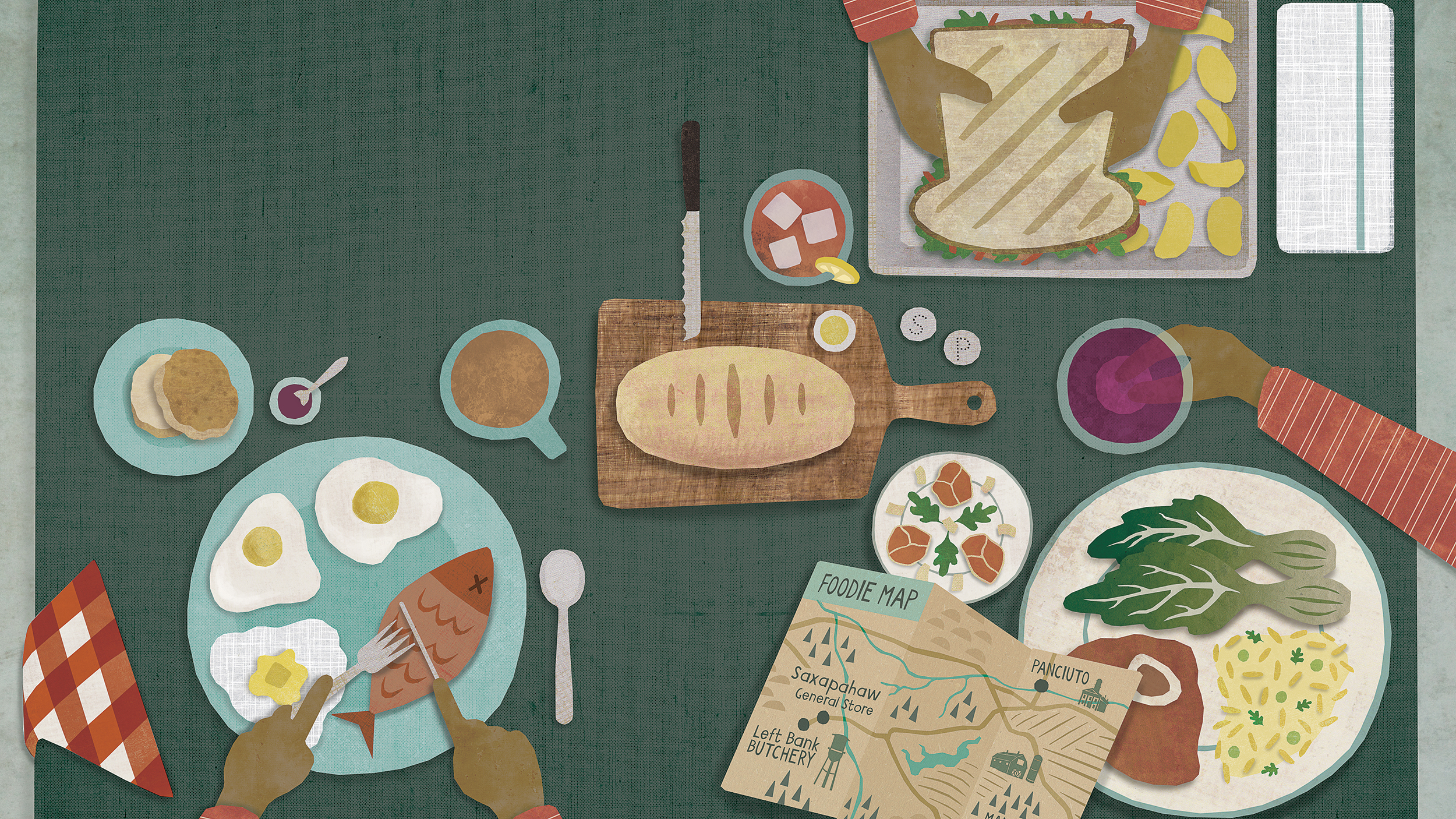
(Illustration by Alice Feagle ’06)
Randall Kenan ’85 writes, thinks, explores and dreams in food — always branching out and forever returning to his culinary cradle.
by Robert Bradford
Randall Kenan ’85 remembers summer mornings like this one in Chinquapin, in rural eastern North Carolina: The heat’s already up, and he and the woman who raised him — his great-aunt Mary Fleming Kenan Hall — are harvesting vegetables. Kenan is 6, and he knows every foot of this huge garden, its peppers, okra, collard greens, tomatoes and green beans. The collards go in a pot with ham hocks and cook for hours. That — with homemade pepper sauce, cornbread and sliced tomatoes — will be their dinner.
“That was the way we lived,” Kenan said. “We grew our own food and raised chickens and hogs. We ate pretty much off the land.”
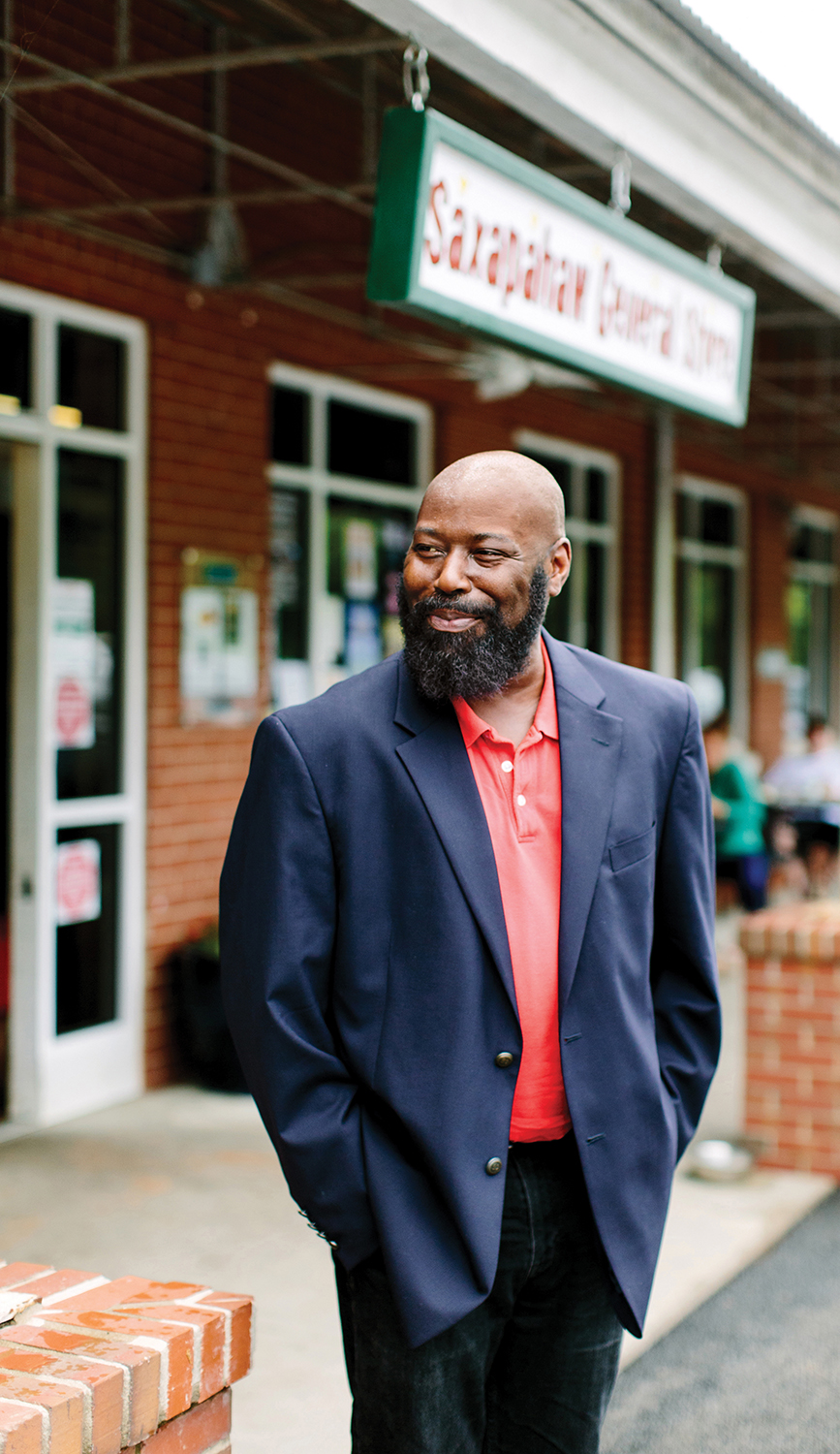
Randall Kenan ’85 (Anagram photo/Anna Routh Barzin ’07)
Now a professor of English and comparative literature at Carolina who writes about food and teaches creative writing — including a course on food writing — Kenan has pushed his taste horizons out quite a bit. But the garden, how they killed their own hogs, the necessity of local food remain near his heart.
A book he edited a couple of years ago, The Carolina Table: North Carolina Writers on Food, focuses on his lifelong interest in food, culture and community. In his travels, he makes it a point to visit restaurants and experience the food of cultures across the country and the world. He can move quickly from talking about the best way to make pho, the traditional soup of Vietnam, to the nuances of risotto. Still, Kenan is drawn to the food of the South and of North Carolina, and he sees the state as a proving ground for new Southern cooking.
So we asked him to take us on a culinary tour of the area, to craft one great day of eating from start to finish. He picked the places and made his selections of that day’s meals. (Any reader might have three alternative spots for such a make-a-day-of-meals assignment; if, as you read this, you feel inspired to share your idea of a perfect day of eating out in the vicinity of Chapel Hill, let us know. You know how to find us … .) Following is some of the dialogue from Kenan’s one-day gastronomic journey.
Breakfast: Chapel Hill
Kenan sits down at a table and orders a breakfast that speaks to him: fried catfish, two eggs over easy, grits and biscuits.
“I had a great-great-aunt, and she always had fish for breakfast. I thought that very strange in the 1970s and ’80s, and I would ask her why she had fish for breakfast. And she said, ‘Why not?’ So I think of her when I have fish for breakfast.”
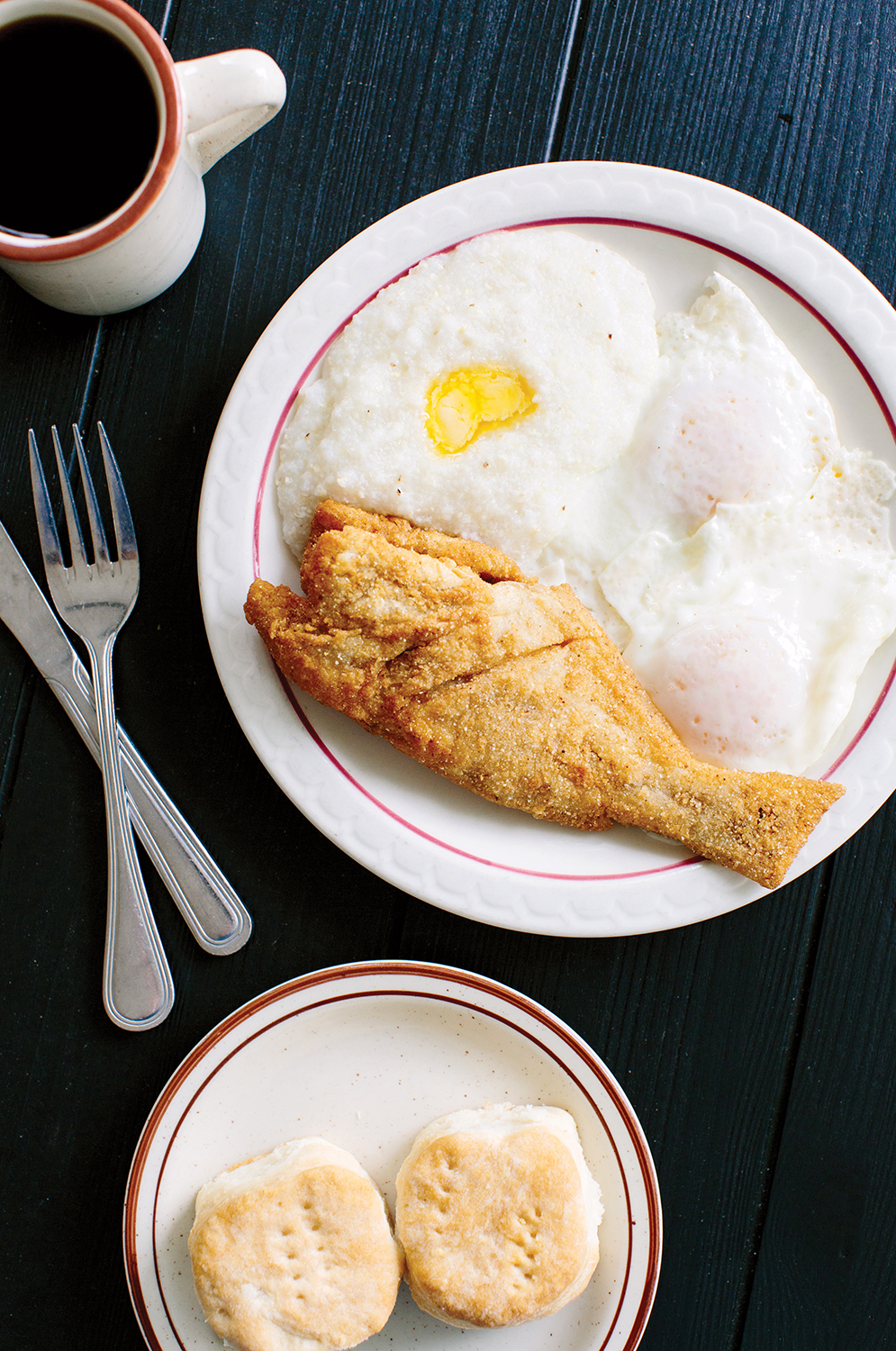
Fried catfish for breakfast, with two eggs, grits and biscuits at Mama Dip’s Kitchen. (Anagram photo/Anna Routh Barzin ’07)
During Kenan’s student days in the 1980s, Mama Dip’s was the perfect place for him to get the food of his childhood. “I sang in the [Black Student Movement] gospel choir at Carolina, and some members told me about Mama Dip’s. It sort of became the place to go.
“I remember the fried chicken and that sort of thing. And there were things that I really, really loved that some of my friends would not have countenanced — like chitlins or liver and onions. This might have been one of the few places where I would trust somebody else’s chitlins.”
A place like Dip’s reinforces the idea of food as memory. Kenan recalls Ralph Ellison’s Invisible Man and the narrator eating a yam on the streets of Harlem:
I took a bite, finding it as sweet and hot as any I’d ever had, and was overcome with such a surge of homesickness that I turned away to keep my control. I walked along, munching the yam, just as suddenly overcome by an intense feeling of freedom — simply because I was eating while walking along the street. It was exhilarating.
Beyond the food, there is the strong sense of community that has made Mama Dip’s a mainstay in Chapel Hill for decades. At the end of a recent semester, Kenan took his food writing class to Dip’s as a reward — they were surrounded by a family from the First Baptist Church, UNC professors and tourists who have seen Mildred Council cook on the Today show.
“I’m surprised how many of my students have never been here. I think people are drawn to this place because this is food that is true to the region, and I want to share that with my students.”
Lunch: Saxapahaw
Saxapahaw, a mill town northwest of Chapel Hill with about 2,000 people, has been reinvented in the past decade. Kenan makes frequent treks to the town for food and locally butchered meat. In a stretch of what amounts to a city block, there’s the Saxapahaw General Store, which pushes the boundaries of Southern cooking through its focus on international cuisine fused with locally grown, sustainable ingredients; Left Bank Butchery, a marriage of an old-school Southern meat market and a French charcuterie; the Eddy, a festive pub and eatery; and the Haw River Ballroom, which features national touring bands and local artists.
“This is what makes North Carolina, and especially the Triangle, so exciting right now. It’s looking out and bringing things in,” Kenan says. “It’s unexpected — I don’t think people would think a town this tiny would have food this interesting.”
As he contemplates the eclectic menu at the Saxapahaw General Store — Southern inspired banh-mi, carnitas, duck jam hamburgers, eggs Catalan or a fried oyster po’ boy — Kenan runs into an old writing friend from Carolina and chats briefly with the owner of the reimagined general store. There’s a sense of family here.
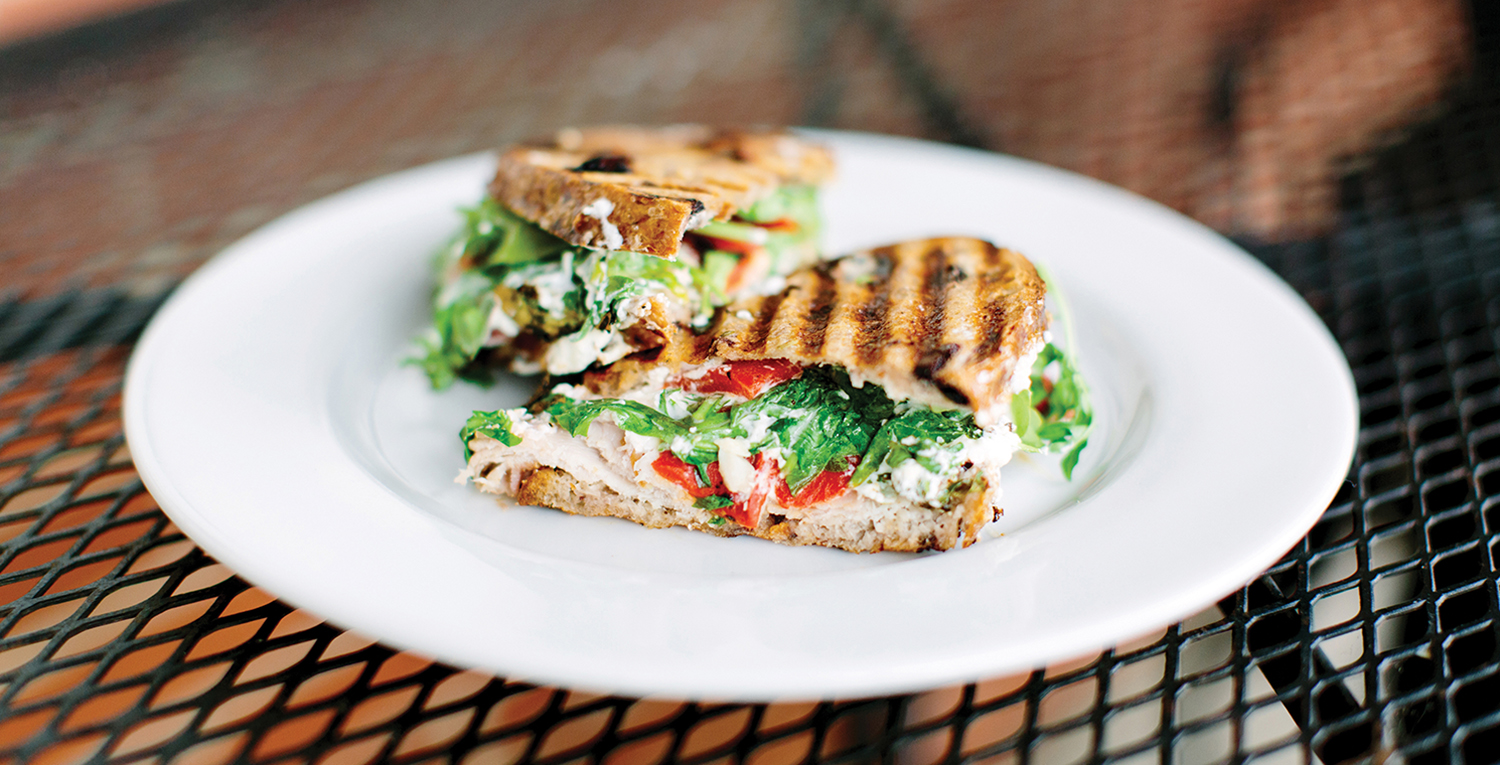
House-smoked pork loin sandwich with arugula, roasted red peppers, goat cheese and an olive-and-rosemary bread at Saxapahaw General Store. (Anagram photo/Anna Routh Barzin ’07)
He orders the house-smoked pork loin sandwich with arugula, roasted red peppers, goat cheese, and an olive-and-rosemary bread made on site. “I’m big on hogs,” he explains as he bites into the sandwich.
After lunch, he heads to the butchery to pick up a pound of Toulouse sausage, which is made from pigs raised locally and is ground with thyme, parsley, garlic, white wine and lemon zest. He’ll take it home and grill it for lunch tomorrow with peppers, onions and potatoes.
Kenan completes his time in Saxapahaw with a walk down a pathway on the Haw River and reflects on the importance of food in literature.
“Gertrude Stein once said that if you have your characters sit down to eat, and they don’t tell you what they ate, it’s very rude. There are many writers who include food in their work. Hemingway does food very well. In Toni Morrison’s work, food shows up in interesting places.
“I think a lot of people still think of Southern food in stereotypical ways, but we know better. Some stereotypes die hard.”
— Randall Kenan ’85
“I just published a story, ‘Resurrection Hardware,’ in the Oxford American about a food-writer type who buys a house out here that’s haunted. I keep looking for it every time I come out here.”
In one scene, the narrator describes a meal he cooked for guests — it could be a meal that Kenan made himself:
The goose came out just fine — succulent, flavorful, the fat a thing of pure joy. My sauce, not too sweet yet tangy. I was happy with my decision to use so much ginger. The potatoes were overdone, but an over-cooked potato is not the end of civilization. The Brussels sprouts made me proudest, which is silly. But their consistency, their texture, the crunch, the amount of doneness made me exceedingly happy.
“For me, I think I understood from the beginning how food was connected to identity and place,” Kenan says. “The very first thing I had published in a book was an excerpt from my first novel about a hog killing. And I have used food in my writing ever since.”
Dinner: Hillsborough
“I think a lot of people still think of Southern food in stereotypical ways, but we know better. Some stereotypes die hard,” Kenan says.
Panciuto defies them. The chef-owner, Aaron Vandermark, lives in the world between Italian and Southern food, and like Alice Waters at Chez Panisse in Berkeley or Bill Smith ’72 at Crook’s Corner in Chapel Hill, Vandermark focuses on fresh ingredients that drive his menus.
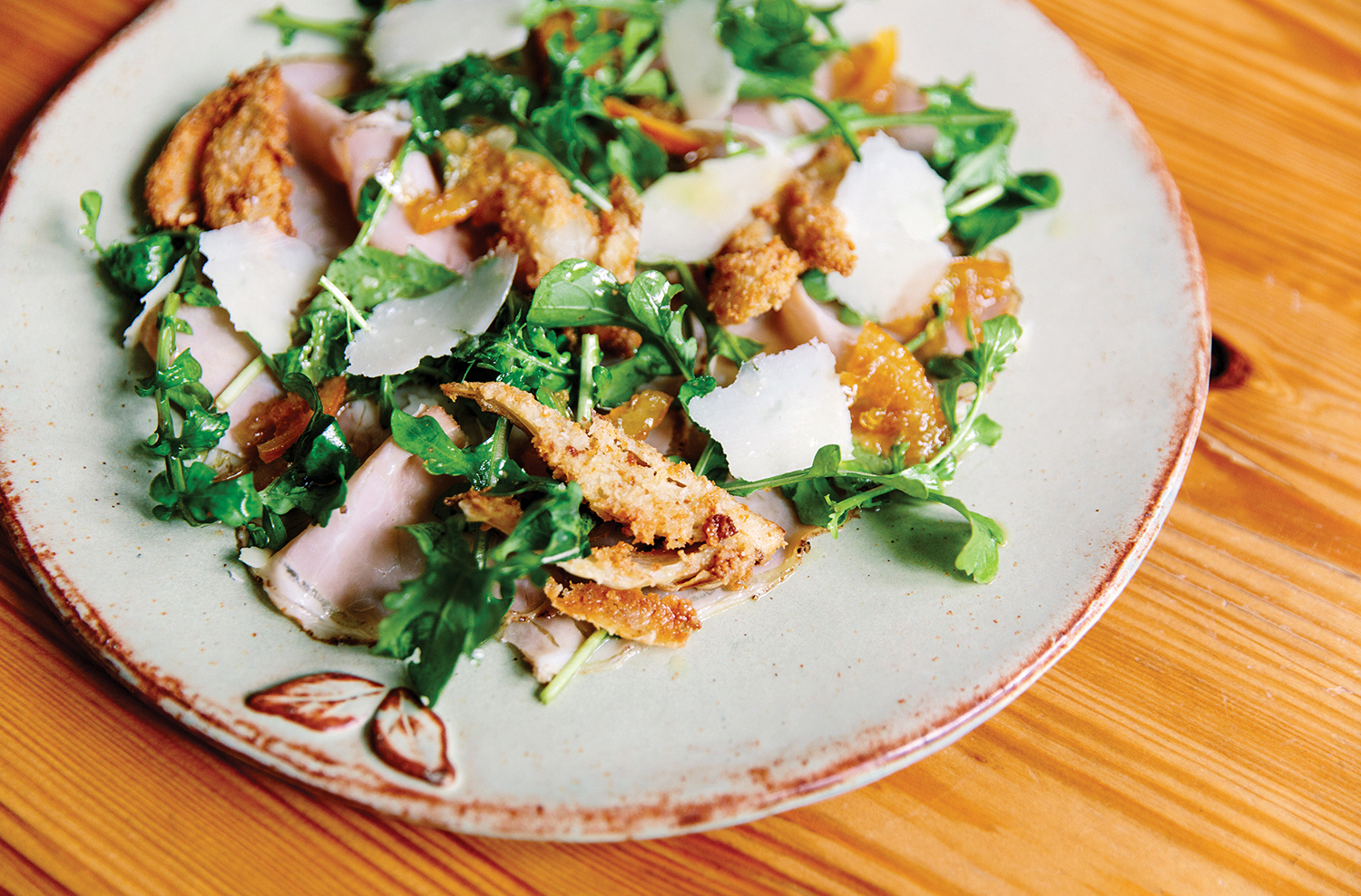
Shaved pork loin carpaccio at Panciuto. (Anagram photo/Anna Routh Barzin ’07)
Kenan starts his meal with carpaccio made from shaved pork loin from a hog that likely was raised and butchered within a few miles from the restaurant. The carpaccio includes local mustard greens and Pecorino Romano. Kenan’s main course is a riff on the classic Italian osso bucco, featuring a pork shank rather than veal and an interesting marriage of black bean curd, chili oil, toasted saffron rice, scallions, parsley and crispy bok choy.
“I have a friend, James Peacock, a retired anthropology professor at UNC, and in his books he writes about the idea of the global South. He talks about the idea that geography and culture are not bound by land. He talks about the South as a place that is mixing and matching cultures all over the world. This is a great example to me of the global South.”
Kenan believes this notion of the global South, what Jimmy Carter has called “the hopeful view of how we can engage the world while keeping, and even enhancing, the best of what the South has to offer,” is thriving in the Triangle. When he walks down Franklin Street today, he sees Thai, Vietnamese, Indian, Turkish, Szechuan, Mexican and Mediterranean restaurants alongside Sutton’s Drug Store and Top of the Hill. The old location of Mama Dip’s that he knew as a student is now occupied by a Latino market, where one can buy fresh tomatillos, dried guajillo chiles
and chorizo.
Kenan finishes his meal at Panciuto with a cup of coffee as snow falls outside the restaurant. It’s late March, and it was 70 degrees just a few days ago. But he’s not thinking about winter; he’s thinking about the spring and the summer and his great-aunt’s garden. He’s thinking about greens — collards and mustards and cabbage and turnips. He’s thinking about carrots and radishes and butter beans and peas and okra. He’s thinking about what local chefs will do with these ingredients and how he’ll use them in his kitchen.
“I do dream and wonder about our state’s culinary future,” Kenan writes in the introduction to The Carolina Table. “What will newcomers bring and support, what of our past will they adopt, what blends and hybrids might occur, what new crops will we begin to grow, what new uses might we discover for sweet potatoes and tobacco plants and pine needles and the humble butter bean?”
Robert Bradford is a freelance writer based in Carrboro.
Thanks for reading the Carolina Alumni Review
Carolina Alumni members, sign in to continue reading.
Not yet a member? Become one today.
